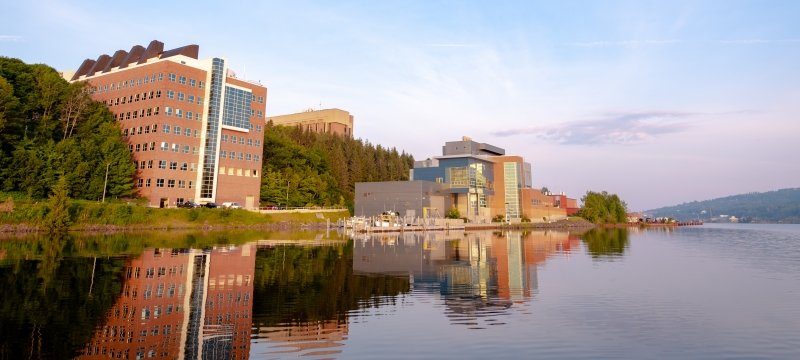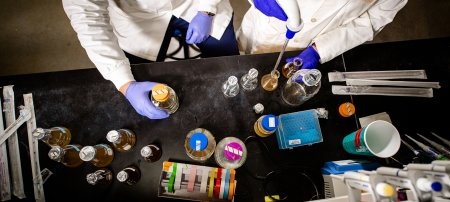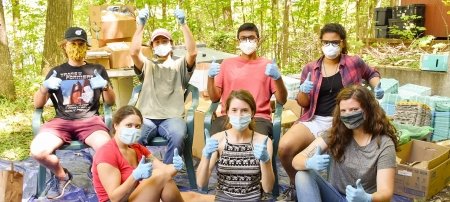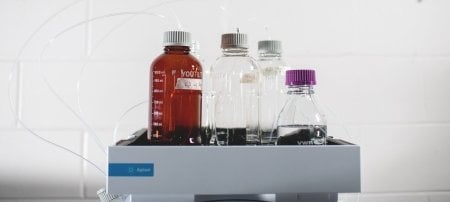Michigan Tech researchers have been selected for a $7.2 million DARPA cooperative agreement award to turn military plastic waste into protein powder and lubricants.
It’s a well-documented fact that we have a plastic problem. Plastic is so ubiquitous in packaging, many people don’t even think twice about tossing it in the trash, even though it will likely end up polluting the environment or the oceans in some way.
But others have begun to wonder if there is a brighter future for plastic, which after all, took a lot of resources to produce. These people envision a more nutritious future for the material that arguably most defines post-industrial life. They ask, can plastic be converted into food?
About the Researcher
Wait, what?
It’s not as crazy as it sounds, and it involves some pretty nifty chemical acrobatics.
Steve Techtmann, assistant professor of biological sciences at Michigan Technological University, has been selected to receive a Defense Advanced Research Projects Agency (DARPA) cooperative agreement award for $7.2 million over four years to refine a method of chemical and high heat (pyrolysis) deconstruction of plastic waste into protein powder and lubricants. The project, BioPROTEIN (Biological Plastic Reuse by Olefin and Ester Transforming Engineered Isolates and Natural Consortia), is a collaboration between Michigan Tech and Ting Lu, professor of bioengineering at the University of Illinois at Urbana-Champaign. At Michigan Tech, joining Techtmann are chemical engineers Rebecca Ong and David Shonnard and materials engineer Joshua Pearce.
“What we’re trying to do overall is to take plastic or mixed waste from military operations and make it into something useful for the military,” Techtmann said. “Often, plastic is the hardest waste to deal with. Our project is trying to find ways to convert waste plastic into protein powder or nutritional supplements and lubricants. The general idea is that plastic is hard to break down using biology because it’s made up of a polymer, and its units are stuck together. To break apart the polymer, some bacteria can do this, but it’s very slow. So, to convert plastic into food quickly, we need an alternative approach.”

Design, Recover, Integrate
The four-year project is broken into three phases. During the first phase, the research team will show its proof of concept, that it can turn waste plastic into protein powder and lubricant. They will design and use the separations system to recover 2.5 grams of microbial protein powder.
“There are systems for dealing with plastic where you recycle it. Michigan Tech made one where you take a plastic waste object and turn it into a new, valuable plastic product,” Techtmann said. “Our plan is to put plastic in and turn it into something entirely different on the other side of the box.”
"This research will allow us to take the plastic waste we’re generating in the world and turn it into something valuable: food and fuel."
The second phase is to demonstrate the team can put the individual parts together to recover 100 grams of microbial protein powder from culture medium.
In the final phase, the team will turn their “black box” into a field operational unit that can integrate separations into the system and purify kilograms of protein powder at a time from the recovered media. The goal is for the system to be self-sustaining for as long as 28 days, and for it to fit on the back of a truck and use solar energy for power. Additionally, the team will 3D print many of the system components and make these designs open source, making the system affordable in settings beyond the military, such as in disaster relief scenarios.
Break It Down, Build It Up
The first step of the process is to convert plastic into compounds that look somewhat like oil using heat and a reactor that can deconstruct plastic’s polymer chains. The oil-like compound is then fed to a community of oil-eating bacteria Techtmann’s lab has been studying. The bacteria grow very fast on their oily diet, producing more bacterial cells, which are about 55% protein. It’s through this process that the team can convert plastic to protein very quickly.
Grants and Funding
DARPA grant HR0011-20-2-0033
The researchers envision a system like this: There’s a slot on one side where soldiers will throw in their plastic waste. The waste goes into processing reactors to be broken down by heat and/or chemicals. Once broken down, the byproduct will be fed into a vat with the bacteria, which chew on whatever flows there and grow. The cells are then dried down into a powder that can be used as needed.
At Illinois, Lu focuses on engineering microbial gene circuits for novel chemical and biomolecule production. Working with the team members at Michigan Tech, he aims to engineer bacteria to upgrade the protein powder with maximum nutrition.
“By enriching specific amino acids and polyunsaturated fatty acids, we hope to increase the nutrient content of the powder and tailor it for military need,” Lu said.
Along the way, the team is working with the funding agency as well as other regulators such as the U.S. Food and Drug Administration to ensure the development of a product that can be used as food and is not toxic in any way.
Techtmann said working with a team of people from different academic backgrounds and research centers — the Great Lakes Research Center and the Sustainable Futures Institute —brings a richness to the project.
“It involves a diversity of people with different expertise,” he said. “The interdisciplinary part is really exciting to me.”
And ultimately, Techtmann sees a need for the system beyond military use.
“This is about generating a technology that we can hand off. We’re developing it for the problem of expeditionary military units, but the technology we would come up with could be scaled to get clean water and food to people who need it in disaster relief,” he said. “It’s a natural outcome of the project to be broader than just in military applications. We’re providing a framework for how we deal with plastic waste in general.”
Michigan Technological University is an R1 public research university founded in 1885 in Houghton, and is home to nearly 7,500 students from more than 60 countries around the world. Consistently ranked among the best universities in the country for return on investment, Michigan's flagship technological university offers more than 120 undergraduate and graduate degree programs in science and technology, engineering, computing, forestry, business, health professions, humanities, mathematics, social sciences, and the arts. The rural campus is situated just miles from Lake Superior in Michigan's Upper Peninsula, offering year-round opportunities for outdoor adventure.







Comments